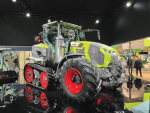While instantly recognised as the major player in construction equipment, Caterpillar Inc, more commonly known as CAT, has its roots set in the farming regions in the west of the United States.
There, two pioneers, Benjamin Holt and Daniel Best, embarked on the mechanisation of agriculture, with a focus on combine harvesters.
Located at Stockton, east of San Francisco, Holt became a leading player in harvester development, adapting machines to run on hillsides, and building the first self-propelled combine powered by an internal combustion engine in 1910. At San Leandro, to the west, Best had built ‘travelling combined harvesters’ in 1885, before introducing of a steam-powered unit in 1889.
Holt focused on combine production, while Best leaned more towards tractors, but a fierce competition developed between the companies during the first few years of the 20th century in the field, but also in the courts as they disputed various patent transgressions. This ended in 1908, when Daniel Best retired and sold two thirds of his company to Benjamin Holt.
Clarence Leo Best, who owned the other third of the business, eventually left to form his own company in 1910, focusing on the manufacture of engine-driven, wheeled, and eventually, tracked tractors.
After the First World War, sales dropped alarmingly, so the new company was restructured and renamed the C.L Best Tractor Company, refocusing on smaller farm scale tractors, whereas Holt was still wedded to the production of larger military machines. The Holt Manufacturing Company had done well during the conflict, selling a number of crawlers to move guns and supplies across the otherwise impassable fields of France. However, come November 1918, crawlers were not needed by the armies.
In the early 1920s, the companies found themselves weakened and struggling, so a merger into a single entity occurred in 1925. The union of the two companies brought into existence what we now know as Caterpillar Inc.
Despite Holt turning the track-laying vehicle into a commercial success, the mechanism was designed and patented by Richard Hornsby and Sons of Grantham in Lincolnshire in 1904. After failing to interest the British Army in the design, the company sold the rights to Holt in 1911. The idea was far from new but what Hornsby & Sons had done was include a separate drive to each track with its own clutch, thus enabling the machine to be steered without the use of a front mounted tiller wheel.
With the range of Caterpillar machines confined to only tracked models, the problem arose for dealers of not being able to offer both tracked and wheeled tractors.
Caterpillar’s only other foray into the agricultural market started in 1986 when it created the Challenger brand of rubber-tracked tractors. This was originally sold in Cat’s own distinctive yellow livery, although a joint venture with the German company Claas saw the product sold in Europe as a Claas Challenger, while harvesters were sold in North America as Cat Lexion. Challenger was eventually sold off to AGCO in 2002, who still produce Fendt Challenger tracked machines up to 673hp.



















